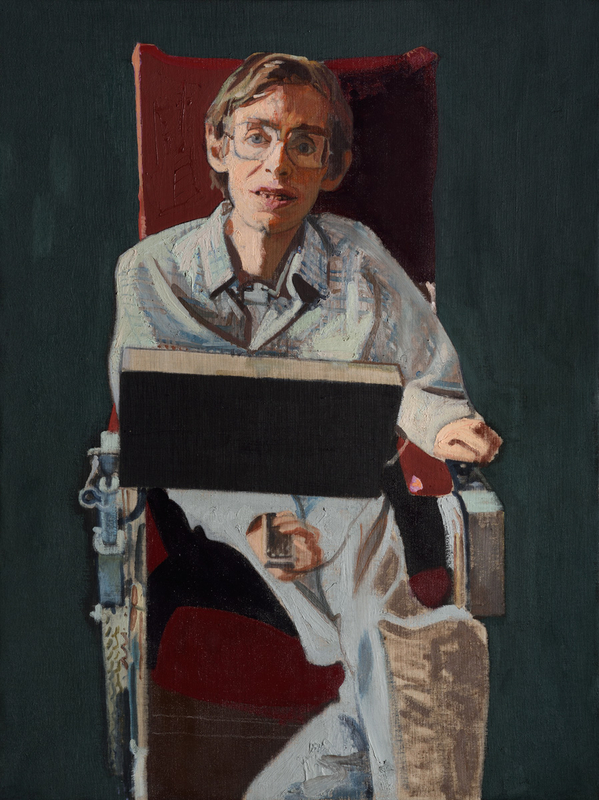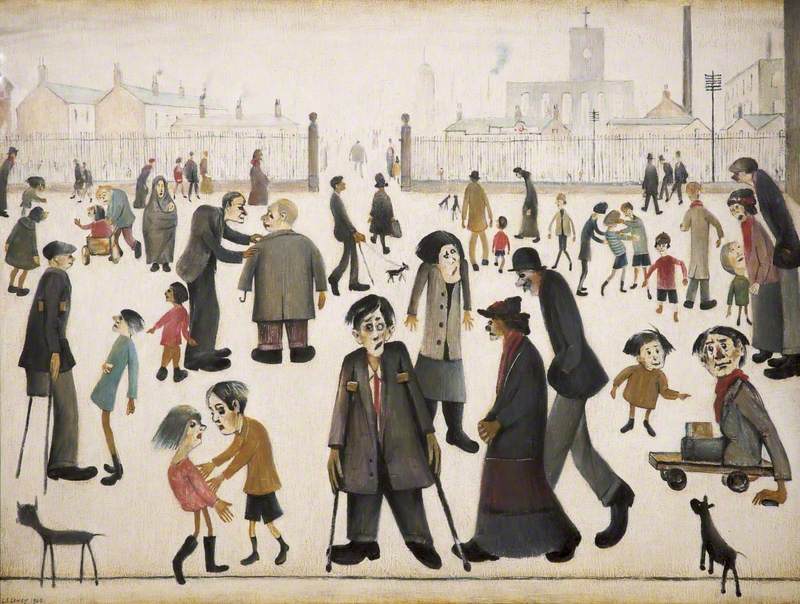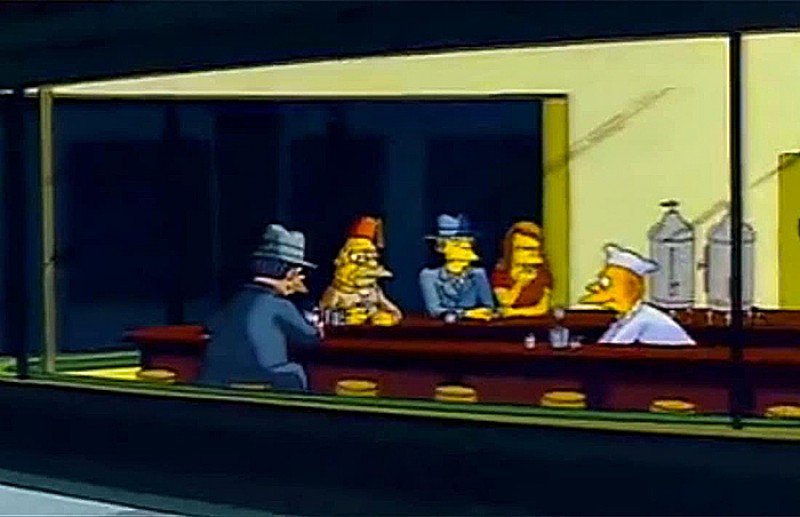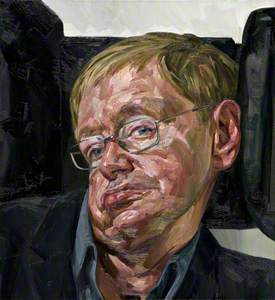In the mid-1980s, the National Portrait Gallery commissioned a series of pictures intended to raise the profiles of some contemporary British scientists who were prominent in their fields but little known to the public. One of these portraits, by Yolanda Sonnabend, was of the Lucasian Professor of Mathematics at Cambridge University, Stephen Hawking.
It was the first of several major portraits of the physicist that would be painted over the next 25 years. These pictures chart not only ordinary ageing but also the progress of Hawking's Motor Neurone Disease (MND), the degenerative condition otherwise known as Amyotrophic Lateral Sclerosis (ALS). They also capture Hawking before, and at various stages of, the global fame that followed the publication of his bestselling book A Brief History of Time in 1988.
It's rare for a scientist to sit for so many important portraits, and even rarer for a disabled person to do so, and considered together the pictures form a compelling visual biography.
The Sonnabend portrait, painted in 1985, shows Hawking in his early 40s. In contrast to many notable paintings of disabled people – L. S. Lowry's The Cripples, for example – the focus is not on the misery supposedly inflicted by his impairments but on his status as a scientist.
There appear to be unfinished equations on the blackboard behind him and we feel that perhaps we have interrupted him at work. Hawking's youthful appearance makes him seem like someone at the beginning of his career – even though, at the time the picture was painted, he had already been appointed to one of the most prestigious posts in academia and had outlived doctors' initial predictions of his life expectancy by 20 years.
Diagnosed with MND in 1963, he had at first been given only a few years to live.
Unlike later pictures, painted after Hawking lost much of the movement in his neck, Paul Gopal-Chowdhury's 1989 portrait shows Hawking sitting upright.
Professor Stephen William Hawking
Paul Gopal-Chowdhury (b.1949) 
Fittingly for a work that hangs in Gonville & Caius College, Cambridge, the professor looks at us as he might at students who want to ask him a question. He's ready to answer, his hand poised on the controller of the speech computer he had begun using in 1986.
This depiction of Hawking as alert, engaged and – crucially – ready to speak counteracts one of the most pervasive myths about him: that, because of the esoteric nature of the work that occupied his mind, and the extent of the disabilities that affected his body, he was separated from society and all but imprisoned in his own world.
When Hawking appeared on BBC Radio 4's Desert Island Discs in 1992, the programme's presenter, Sue Lawley, suggested that, unlike previous guests she'd interviewed, he already knew what it was like to be isolated from the rest of the human race.
It was an idea he rejected outright. A Brief History of Time – like Hawking's lectures and, indeed, like his appearance on Desert Island Discs – demonstrate that, far from being voiceless and alone, Hawking was a born communicator. Gopal-Chowdhury presents him as such.
Gopal-Chowdhury had painted Hawking before: the professor is one of 15 figures in the 1984 picture Fellows at Dessert, which also hangs at Gonville & Caius College.
Hawking sits towards the back of the image, at the far left corner of the dining table, beside the college president. It's significant that Hawking is not immediately identifiable and that it takes us a moment to realise his chair is, in fact, a wheelchair. It's unusual to see a disabled person in art without attention being drawn to their disability. In Fellows at Dessert, Hawking is simply a disabled person shown among a group of professional peers.
In the popular imagination, Hawking was soon to soar above those peers. In 1993 he played a hologram of himself in an episode of Star Trek: The Next Generation, beating holographic re-creations of Sir Isaac Newton and Albert Einstein in a hand of poker organised by the super-intelligent android Data.
In the 1995 Halloween episode of The Simpsons, Homer Simpson causes a rupture in space-time and wails 'I wish I read that book by that wheelchair guy'.
By the mid-1990s, just ten years after Yolanda Sonnabend had painted him as a relatively obscure scientist, Hawking had become so synonymous with science, with genius, and with disability that the writers of The Simpsons could call him 'that wheelchair guy' and be assured their audience would know who they meant, while the writers of Star Trek could credibly assert that Hawking would still be regarded as one of 'the greatest minds in history' 300 years in the future.
When Hawking sat for a portrait by Frederick Cuming in 2005, he was as well-known as any scientist since Einstein.
Looking at Cuming's picture – which, like Sonnabend's, is in the collection of the National Portrait Gallery – we feel we have caught Hawking in a private moment. Unlike the straight-ahead focus of his eyes in the Gopal-Chowdhury picture, here he is intently looking away. This is a painting that compels us to wonder what its subject is thinking, which allows it to play with stereotypes about disability. Once we try to imagine what Stephen Hawking could be thinking, our focus is not on the limitations of his body compared to ours, but on the limitations of our minds compared to his.
Tai-Shan Schierenberg's portrait of Hawking was painted in 2008, the year Hawking stopped using his hand to control his speech synthesiser and began using muscles in his cheek.
In the picture, which is held by the Royal Society, we see that he has lost some of the ability to make easily interpretable facial expressions.
At first, the viewer might think that this painting, like the one by Cuming, shows Hawking deep in thought. Or even that it shows him lost in that abject isolation it's widely believed his MND imposed upon him. But when we look at his eyes we see they are looking directly at us, as alert as they are in the Gopal-Chowdhury portrait from 19 years earlier. Again, we could be students looking to him for insights. In a sense, by 2008, the whole world was.
As Hawking became more and more renowned, his image in the media was – both metaphorically and literally – drawn in broad strokes. His scientific work had to be reported in reductive ways to make sense to the average person, but reductive ideas about him often led to reductive ideas about his disabilities. When Hawking died in 2018, numerous newspaper and internet cartoons were devoted to his death, with some crassly showing him walking away from his wheelchair in ways that proved immediately controversial among many of us who use wheelchairs.
The implication in these simple cartoons often seemed to be that a death that let someone 'walk free' was preferable to life in a wheelchair.
The portraits by Sonnabend, Gopal-Chowdhury, Cuming and Schierenberg stand in contrast to such simplistic pictures. Their great value is in their commitment to depicting both Hawking and disability with nuance and depth.
Scott Jordan Harris, arts journalist



























